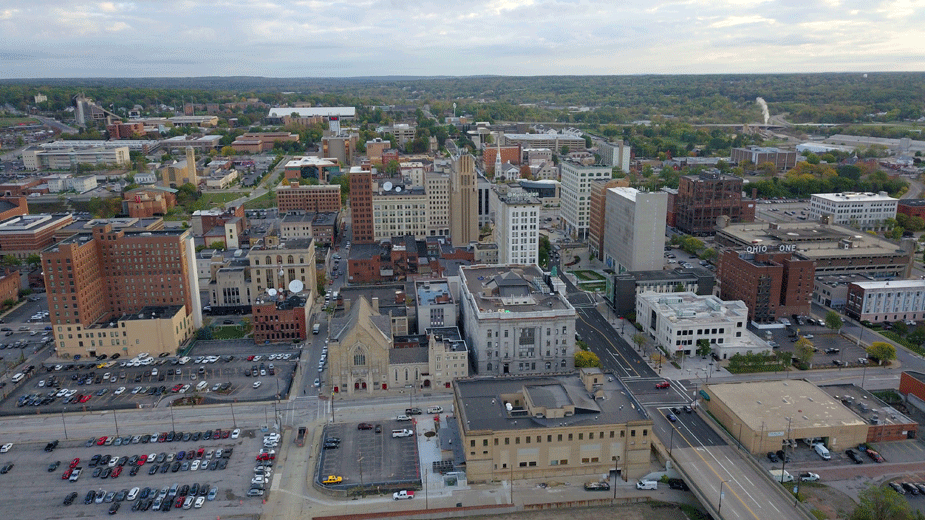YOUNGSTOWN, Ohio – An initiative spearheaded by Economic Action Group Inc. aims to do for commercial properties in Mahoning and Trumbull counties what organizations like the Youngstown Neighborhood Development Corp. and Trumbull Neighborhood Partnership have done for residential properties.
YNDC and TNP are among several local partners in Commercial Property Revitalization, an Economic Action Group collaborative program that aims to redevelop blighted properties in the Mahoning Valley for reinvestment and reuse.
The EAG’s Commercial Property Revitalization project represents several “agencies and entities” interested in revitalizing commercial properties, says Anthony Trevena, economic development director for the Western Reserve Port Authority, another of the partners in the initiative.
The other participants comprise the land bank programs of Mahoning and Trumbull counties, the cities of Youngstown and Warren, Boardman Township, Eastgate Regional Council of Governments and Youngstown State University.
YNDC is doing “great work,” primarily with residential properties, but there was a gap when it came to similarly addressing commercial sites for renovation or, if necessary, demolition, says Nick Chretien, Economic Action Group program manager.
EAG, which has contracts with Youngstown and Warren for development work, provides data to support the efforts of the collaborative.
The Commercial Property Revitalization project has its roots in the redevelopment of 2246 Glenwood Ave. in Youngstown, a building previously used by Rescue Mission of the Mahoning Valley, Chretien says. In 2018, YNDC and the port authority collaborated on redevelopment of the property, now known as Youngstown Business Center.
Chretien, while working for YSU, helped to write grants in support of that project with the intent to design a scalable concept that could be applied elsewhere.
“It illustrated the proof of concept that these types of projects could be done,” Chretien says. It also provided the motivation for a YNDC study of Youngstown’s commercial corridors, which was completed in 2019.
Mahoning County Land Bank helps with gaining “clean and clear” title to commercial properties that owners have walked away from that have renovation potential, says the executive director of the land bank, Deb Flora.
“That’s where the land bank comes in,” she says. It’s a role similar to one the land bank plays with YNDC on residential properties. “We’re looking at commercial properties with an eye toward revitalization and renovation versus demolition,” Flora says, and identifying which buildings can be saved.
In analyzing where the priorities exist, the Mahoning land bank examines real estate data, property conditions, tax foreclosures and other indicators of inactivity, including utilities.
“What we’re looking at tend to be smaller properties,” Flora says. “Any sort of brownfield situation would not go through without a great deal of conversation and background.”
Much of the early focus has been on Youngstown, where an analysis found more than 10% of the square footage and 14% of all commercial buildings are vacant. In Mahoning County, the CPR program identified at least 254 vacant commercial properties, although Chretien acknowledges the data are “less precise” outside of Youngstown.
The city corridors, which connect to communities including Austintown, Boardman, Campbell and Struthers, were the focus of the study conducted for YNDC.
“The goal is to be able to work collaboratively with the adjacent communities,” Chretien says.
Many of the area’s commercial corridors have “dated properties that need investment,” says YNDC Executive Director Ian Beniston. “We’ve made good progress on housing but we’ve got to clean up all the corridors in the city.”
YNDC, which had been focused exclusively on residential redevelopment before the Glenwood Business Center project, has advised the CPR partners on the process. The priority is to identify where there are properties with marketing potential.
The organization recently completed the renovation of a commercial property at 2333 Glenwood Ave., which it is marketing, and helped with the cleanup of a building on Mahoning Avenue that the port authority controls.
“We haven’t had any problems once we have them renovated. So there is a market for varying types of commercial spaces,” Beniston says. “It all comes down to having quality spaces available.”
Redevelopment of the Boardman property previously owned by the former Chemical Bank, at Market Street and Midlothian Boulevard, is “a very good example” of the initiative’s efforts, the port authority’s Trevena says.
“That was a very underutilized asset,” he says. The port authority took control of the property in 2019 and tried to market the property before determining that rehabilitation would be prohibitively expensive and demolished it. A PNC Bank automated teller machine was installed on the site and a building is under construction that will house Dunkin’ Donuts with space for an additional tenant.
“Everyone has their own certain niche,” Trevena says. “We know facilities. We know financing. We know where we fit. Land banks are a great tool for acquiring assets.”
The port authority also has a structural engineer on staff and a staff member experienced in environmental issues, he says.
In addition, EAG has design interns who can assemble portfolios for sites to help potential developers envision future uses.
“There’s a great deal of potential here. In some ways, it could be a way to balance the scales in the city,” Flora says.
Having an inventory of available commercial properties could encourage certain types of businesses to go into areas that lack specific services, such as a grocery store.
“We’re not talking about anything specific yet,” Flora says. “We’re just talking about all the possibilities in terms of attracting investment and making meaningful investments in communities that have certain needs.”
